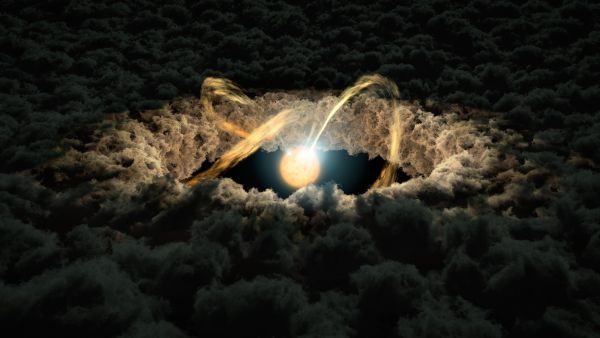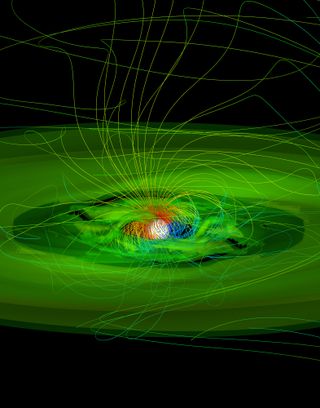Dense 'hot spots' on a young star reveal what Earth's sun may have looked in its infancy

Astronomers may have captured the best view yet of matter colliding with the surface of a young star, findings that may shed light on what the sun looked like in its youth.
Newborn stars are surrounded by a disk of gas and dust from which planets, asteroids, comets and moons are born. The star's magnetic field connects the star with this protoplanetary disk, "funneling material from the disk onto the star," study lead author Catherine Espaillat, an astrophysicist at Boston University, told Space.com.
In the new study, Espaillat and her colleagues investigated the spot where a star's magnetic field deposits protoplanetary disk material onto a star. "This footprint is called the 'hot spot,' since the material is very hot when it slams on to the surface of the star," she explained.
Related: How did the solar system form?

The scientists focused on GM Aurigae, a star about the same mass as the sun located about 420 light-years away in the constellation Auriga. GM Aurigae is only about 2 million years old — in comparison, the sun is about 4.6 billion years old.
Previous work could not get a clear picture of the structure and dynamics of these hot spots. In the new study, the researchers analyze GM Aurigae with multiple observatories — the Hubble, Swift and TESS space telescopes, as well as the Small and Moderate Aperture Research Telescope System in Chile, the Lowell Discovery Telescope in Arizona and the Las Cumbres Observatory global network of telescopes.
"This is the first time such an extensive time-coordinated study has been done on a young star," Espaillat said.
Sign up for the Live Science daily newsletter now
Get the world’s most fascinating discoveries delivered straight to your inbox.
The scientists found the visible light they detected from GM Aurigae peaked in brightness about a day after the ultraviolet light. They suggested this happened because the source of the visible and ultraviolet light moved into and out of view as it rotated along with the star.
When combined with computer models of matter accreting onto stars, these findings suggest the hot spot varies in density from its center to its rim on the star's surface, the researchers said. Areas of the hot spot with different densities have different temperatures, and so emit different wavelengths of light.
"For the first time, we map the structure in this hot spot using observations and confirm theoretical predictions," Espaillat said. "This result teaches us more about what our sun looked like when it was young. Now our sun has sunspots, dark areas where the temperature on the surface is cooler. When our sun was young, it also had hot spots."
Future research will analyze GM Aurigae and other stars to detect more details about these hot spots.
The scientists detailed their findings online Sept. 1 in the journal Nature.
Originally published on Space.com.
Follow us on Twitter @Spacedotcom or Facebook.













